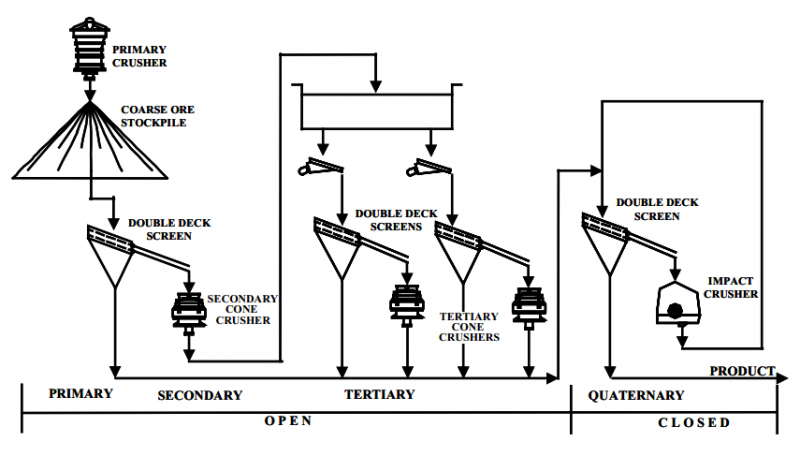Secondary Crushing Simulation

The crushing plant simulator was utilized to evaluate the influence of major variables on the following responses: plant reduction ratio , weight % of -½ inch material in screen undersize, circulating load ratio and secondary screen efficiency. Variables manipulated were: weight % of +1 inch material in secondary crusher feed (73.3 to 92.9%), secondary crusher […]
Dust Scrubbers
Currently, most coal mines rely primarily on two methods for controlling dust. The first utilizes large volumes of outside air to ventilate and dilute the dust (and methane gas) to acceptable concentrations. The second method involves water used in various ways, such as water spray systems. Unfortunately, both techniques have limitations. For example, increasing the […]
Waste Chromic Acid – Sulfuric Acid Etchants Regeneration
Two of the missions of the Bureau of Mines are to conserve scarce, costly metals and to reduce pollution. In accordance with these missions, the objective of this investigation was to develop a method of recycling spent chromium etching solutions that are now discarded as wastes. Solutions containing hexavalent chromium (as chromic acid or sodium […]
Aluminum Dross Furnace Salt Slags Processing
Disposal of the salt slag produced during the processing of aluminum dross and scrap is of particular interest to the secondary aluminum industry. Melting of these materials is carried out under a salt flux cover to dissolve the contaminants, mostly aluminum oxide, and to optimize the recovery of aluminum metal. Typically, dross and low-grade scrap […]
Platinum Electrocatalysts for Oxygen Reduction
This report describes possible material application as oxygen electrode catalysts. The ultimate objective was to assess the potential of abundant, less costly materials as substitutes for platinum, or to increase the efficiency of platinum when used as an oxygen electrocatalyst. Presently, imports account for essentially all of the U.S. requirement for primary platinum metals. The […]
pH Control in Solvent Extraction Circuits
The control of pH in solvent extraction circuits is an old technique but one which has a large potential for future use. The equilibrium position of any reaction which has hydrogen or hydroxide ions, either as products or as reactants, can be controlled by pH adjustment. Several examples of reaction types which are important in […]
Improve Heap Leaching Percolation Rate
To insure the continuing viability of the domestic minerals and materials economy and the maintenance of an adequate minerals base, the U.S. Department of the Interior, Bureau of Mines, has been investigating the development of methods for improving gold and silver recovery from low-grade resources. Discoveries during the past decade of numerous low-grade, gold-silver deposits […]
Oxide Copper Leach Modeling
In recent years interest in hydrometallurgy, particularly in the case of in-situ leaching and solution mining has remained at a high level. There are several studies published on the development of scale-up principles. D’Andrea and Runke described research on in-situ copper leaching at the Emerald Isle Mine whose dominant copper mineral is chrysocolla. The program […]
Sulfuric Acid Leaching of Smelter Matte
It has long been recognized that the 9 million tons of lead ore mined annually from Missouri’s Lead Belt (83 pct of the U.S. domestic production) contain significant amounts of nickel and cobalt. Yet, neither of these important commodities is being recovered by the current processing depicted in figure 1. The pyrometallurgical treatment of primary […]
Wet VS Dry Particle Size Analysis
The analysis of particle size distributions has become increasingly important in industrial processes. Particle size is recognized to be fundamental to the control of operations as diverse as grinding, crystallization, emulsification, agglomeration, and more. Particle size determination has traditionally been relegated to the laboratory, and is performed by slow, labor-intensive methods such as sieving, sedimentation […]
